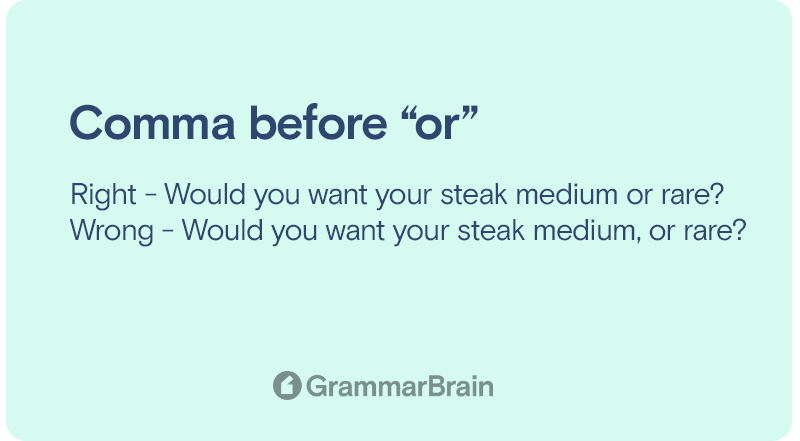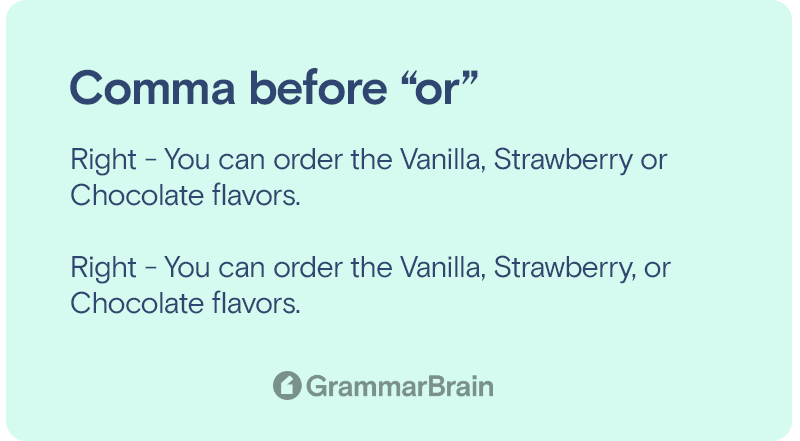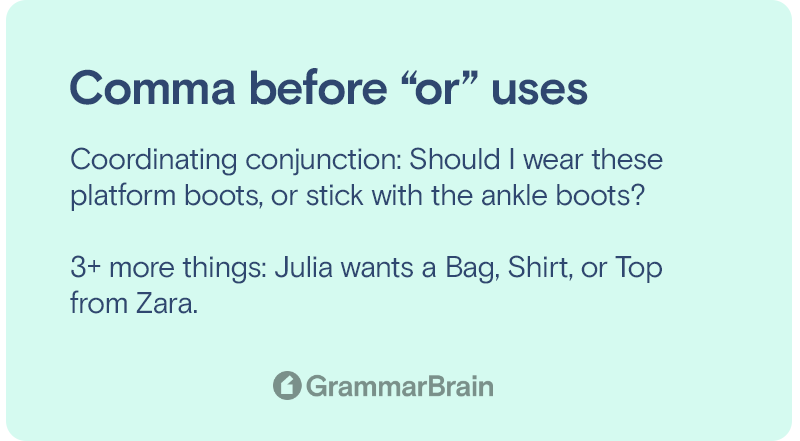Do you put a comma before the word “or?” It’s no secret that the majority of us struggle with placing commas, especially in professional writing. The confusion comes when we aren’t sure about placing a comma before conjunctions.

Conjunctions refer to:
- Or
- And
- Because
- So
The coordinating conjunction here is ‘Or’ since it coordinates 2 elements that have equal syntactic importance. It means 2 things that have the same grammatical weight.
Today, in this article, we will be discussing the appropriate ways to use commas. It will help you gain clarity on the issue.
Do You Put a Comma Before Or?
The answer is how you use the ‘Or’ conjunction. If your sentence is starting with an independent clause, then you should put a comma before “or.”
However, if it starts with a dependent clause, you should avoid the comma placement. But in a list or series of 2-3 items, inserting a comma before or is perfectly okay.
However, it’s not a rule and more of a preference thing depending on the writer.
Seems confusing, right? Let’s break down some differences through examples.
Sentence Examples
You should always avoid separating 2 short grammatical elements whenever they are coordinated with the ‘or’ conjunction.
- Right – Would you want your steak medium or rare?
- Wrong – Would you want your steak medium, or rare?
- Right – Do you like to sing or dance?
- Wrong – Do you like to sing, or dance?
- Right – Do you prefer Ketchup or Mayonnaise?
- Wrong – Do you prefer Ketchup, or Mayonnaise?
Did you notice the inconvenience of adding a comma between the two words separated by or? Hence, it’s incorrect to place them in such scenarios.
It would help if you used a comma in a list of 3+ things.
Let’s take a look at some examples of this:
- Right – You can order the Vanilla, Strawberry or Chocolate flavors.
- Right – You can order the Vanilla, Strawberry, or Chocolate flavors.
The first sentence has a single comma, and the second one has a double. But both are correct and read perfectly fine.

Do You Put a Comma After Or?
Putting a comma after “or” isn’t very common and is more rare to see than not. But is it grammatically incorrect to do this? No.
The only scenario where you would be required to put a comma after “or” is during the usage of a clausal introduction or a parenthetical expression.
Whenever ‘or’ is preceding a parenthetical phrase, you can use a comma after or. We insert a comma both before and after when we use commas for setting apart parenthetical phrases.
The placement of post-comma is less likely but possible. Whenever you write a parenthetical expression in a sentence, commas are needed by default.
So, a comma is bound to come after or whenever it’s the final word under parenthesis. Your information garners better focus and clarity when you parenthesize it.

Sentence Examples
Let’s take an example of this case:
- You can decide to blow your salary on constant partying, or, if I were you, I’d save it for a rainy day.
- You can choose to buy a new phone, or, if I were you, I’d spend it on clothes.
Here, the parenthetical thought is ‘If I Were You.’ It can be removed, but the sentence will remain unaffected.
You can only use commas after or in these situations.

More Examples of using a Comma Before “Or”
Now that we have an idea about commas before or after let’s look at some of these sentence examples:
As a Coordinating Conjunction (Comma Before Or)
- My boss is either firing me after the meeting, or she will increase my working hours.
- Should I wear these platform boots, or stick with the ankle boots?
- My dietitian will ask me to go on a stricter diet, or to hire a personal trainer.
- Should we visit Ireland this summer, or should we just wait and see Paris next year?
- I may join UCLA this year, or I might take a year gap to explore other ventures.
Comma Before Or (For 3 or More Things)
- Julia wants a bag, shirt, or top from Zara.
- I want to attend Brown, Harvard, or CSULA for college.
- We want Tiramisu, Strawberry Shortcake, or Russian Honey cake for dessert.
- Out of all the Tekken Characters, do you prefer Jin Kazama, Nina Williams, or Kazuya Mishima?
- The company couldn’t choose between the former teacher, the Harvard graduate, or the military veteran.
- I would love to visit London, Rome, or Paris next summer.
Comma After Or
- I can cook lasagna for lunch, or, if you want, we can always order takeout.
- He might stay back here, or, despite his girlfriend’s objections, he might take the job in France.
- We can work on Facebook ads, or, if it sounds better, we can go for Instagram marketing this month.
General Comma Grammar Rules to Follow
Using commas and knowing where to exactly place them can be confusing for some people. Here’s what you need to truly know with these rules:
- Use a comma for separating independent clauses.
- You can also use it after an introductory phrase or clause.
- Another rule is to use a comma between every item within a list or series.
- Use commas for setting off nonrestrictive clauses.
- You can also set off the appositives by using a comma.
- Utilize a comma to indicate a direct address.
- Use a comma for setting off direct quotations.
- You can also use commas with numbers, dates, titles, and addresses.
FAQs
Do you use a comma after or?
You can use a comma after or when there is a parenthetical expression within the sentence. It is also done when there is a clausal introduction.
Can you start a sentence with “or?”
Yes, you can undoubtedly start a sentence with an Or. No rule goes against using conjunctions at the start of sentences.
Plus, it helps in creating emphasis and impact on your sentences.
How do you use “or” in a sentence?
You can use the ‘or’ conjunction when there is a negative form of the verb. For example – I don’t like Martinis or Mojitos.
What is the oxford comma rule?
The comma is placed before the conjunction towards the end of a series or list of things. Here, for example – The new logo colors consisted of purple, blue, and white.
Inside this article
Fact checked:
Content is rigorously reviewed by a team of qualified and experienced fact checkers. Fact checkers review articles for factual accuracy, relevance, and timeliness. Learn more.
Core lessons
Glossary
- Abstract Noun
- Accusative Case
- Anecdote
- Antonym
- Active Sentence
- Adverb
- Adjective
- Allegory
- Alliteration
- Adjective Clause
- Adjective Phrase
- Ampersand
- Anastrophe
- Adverbial Clause
- Appositive Phrase
- Clause
- Compound Adjective
- Complex Sentence
- Compound Words
- Compound Predicate
- Common Noun
- Comparative Adjective
- Comparative and Superlative
- Compound Noun
- Compound Subject
- Compound Sentence
- Copular Verb
- Collective Noun
- Colloquialism
- Conciseness
- Consonance
- Conditional
- Concrete Noun
- Conjunction
- Conjugation
- Conditional Sentence
- Comma Splice
- Correlative Conjunction
- Coordinating Conjunction
- Coordinate Adjective
- Cumulative Adjective
- Dative Case
- Determiner
- Declarative Sentence
- Declarative Statement
- Direct Object Pronoun
- Direct Object
- Diction
- Diphthong
- Dangling Modifier
- Demonstrative Pronoun
- Demonstrative Adjective
- Direct Characterization
- Definite Article
- Doublespeak
- False Dilemma Fallacy
- Future Perfect Progressive
- Future Simple
- Future Perfect Continuous
- Future Perfect
- First Conditional
- Irregular Adjective
- Irregular Verb
- Imperative Sentence
- Indefinite Article
- Intransitive Verb
- Introductory Phrase
- Indefinite Pronoun
- Indirect Characterization
- Interrogative Sentence
- Intensive Pronoun
- Inanimate Object
- Indefinite Tense
- Infinitive Phrase
- Interjection
- Intensifier
- Infinitive
- Indicative Mood
- Participle
- Parallelism
- Prepositional Phrase
- Past Simple Tense
- Past Continuous Tense
- Past Perfect Tense
- Past Progressive Tense
- Present Simple Tense
- Present Perfect Tense
- Personal Pronoun
- Personification
- Persuasive Writing
- Parallel Structure
- Phrasal Verb
- Predicate Adjective
- Predicate Nominative
- Phonetic Language
- Plural Noun
- Punctuation
- Punctuation Marks
- Preposition
- Preposition of Place
- Parts of Speech
- Possessive Adjective
- Possessive Determiner
- Possessive Case
- Possessive Noun
- Proper Adjective
- Proper Noun
- Present Participle
- Prefix
- Predicate



